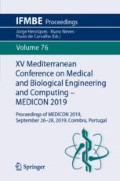Abstract
The importance of visual N2 Event-Related Potential (ERP) component in the study of cognitive processes lies in its interpretation as a measure of the allocation of visual attention to possible targets. Unfortunately, the N2 component has a small amplitude and the domain of validity of methods used for its estimation is difficult to assess if real data are considered. Here, we develop a computer simulator of ERP measurements emulating the variability of the visual N2 component and use the synthetic data to evaluate the performance of four popular literature ERP estimation methods. Results confirmed that a solid simulation framework could allow identifying a reliable method to detect small-amplitude ERP components and quantifying its accuracy.
Access this chapter
Tax calculation will be finalised at checkout
Purchases are for personal use only
References
Luck, S.J., Hillyard, S.A.: Electrophysiological correlates of feature analysis during visual search. Psychophysiology 31(3), 291–308 (1994)
Eimer, M.: The N2pc component as an indicator of attentional selectivity. Electroencephalogr. Clin. Neurophysiol. 99(3), 225–234 (1996)
Hickey, C., Di Lollo, V., McDonald, J.J.: Electrophysiological indices of target and distractor processing in visual search. J. Cogn. Neurosci. 21(4), 760–775 (2009)
D’Avanzo, C., Goljahani, A., Pillonetto, G., De Nicolao, G., Sparacino, G.: A multi-task learning approach for the extraction of single-trial evoked potentials. Comput. Methods Programs Biomed. 110(2), 125–136 (2013)
D’Avanzo, C., Schiff, S., Amodio, P., Sparacino, G.: A Bayesian method to estimate single-trial event-related potentials with application to the study of the P300 variability. J. Neurosci. Methods 198(1), 114–124 (2011)
Ouyang, G., Hildebrandt, A., Sommer, W., Zhou, C.: Exploiting the intra-subject latency variability from single-trial event-related potentials in the P3 time range: a review and comparative evaluation of methods. Neurosci. Biobehav. Rev. 75, 1–21 (2017)
Kiesel, A., Miller, J., Jolicœur, P., Brisson, B.: Measurement of ERP latency differences: a comparison of single-participant and jackknife-based scoring methods. Psychophysiology 45(2), 250–274 (2008)
Delorme, A., Makeig, S.: EEGLAB: an open source toolbox for analysis of single-trial EEG dynamics including independent component analysis. J. Neurosci. Methods 134(1), 9–21 (2004)
Akaike, H.: A new look at the statistical model identification. IEEE Trans. Automat. Contr. 19(6), 716–723 (1974)
Steinberg, H.-W., Gasser, T., Franke, J.: Fitting autoregressive models to EEG time series: an empirical comparison of estimates of the order. IEEE Trans. Acoust. 33(1), 143–150 (1985)
Cerutti, S., Chiarenza, G., Liberati, D., Mascellani, P., Paves, G.: A parametric method of identification. IEEE Trans. Biomed. Eng. 35(9), 701–711 (1988)
Anderson, C.W., Stolz, E.A., Shamsunder, S.: Multivariate autoregressive models for classification of spontaneous electroencephalographic signals during mental tasks. IEEE Trans. Biomed. Eng. 45(3), 277–286 (1998)
Riedel, H., Granzow, M., Kollmeier, B.: Single-sweep-based methods to improve the quality of auditory brain stem responses part II: averaging methods. Zeitschrift für Audiol. 40(2), 62–85 (2001)
Fukami, T., Watanabe, J., Ishikawa, F.: Robust estimation of event-related potentials via particle filter. Comput. Methods Programs Biomed. 125, 26–36 (2016)
Author information
Authors and Affiliations
Corresponding author
Editor information
Editors and Affiliations
Ethics declarations
None
Rights and permissions
Copyright information
© 2020 Springer Nature Switzerland AG
About this paper
Cite this paper
Marturano, F., Brigadoi, S., Doro, M., Dell’Acqua, R., Sparacino, G. (2020). Development of a Computer Simulator of the Visual N2 Event-Related Potential Component for the Study of Cognitive Processes. In: Henriques, J., Neves, N., de Carvalho, P. (eds) XV Mediterranean Conference on Medical and Biological Engineering and Computing – MEDICON 2019. MEDICON 2019. IFMBE Proceedings, vol 76. Springer, Cham. https://doi.org/10.1007/978-3-030-31635-8_4
Download citation
DOI: https://doi.org/10.1007/978-3-030-31635-8_4
Published:
Publisher Name: Springer, Cham
Print ISBN: 978-3-030-31634-1
Online ISBN: 978-3-030-31635-8
eBook Packages: EngineeringEngineering (R0)

